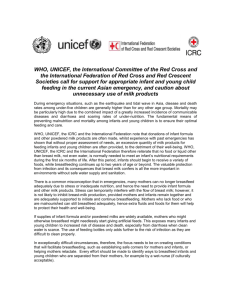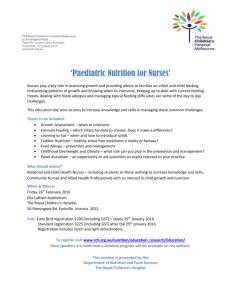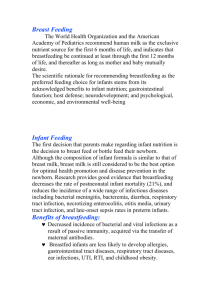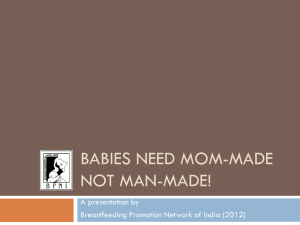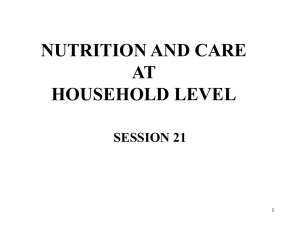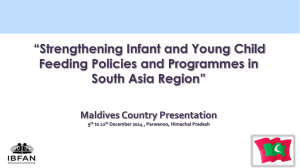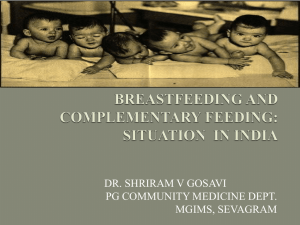northern_syria-_iycf_joint_statement_en (English)
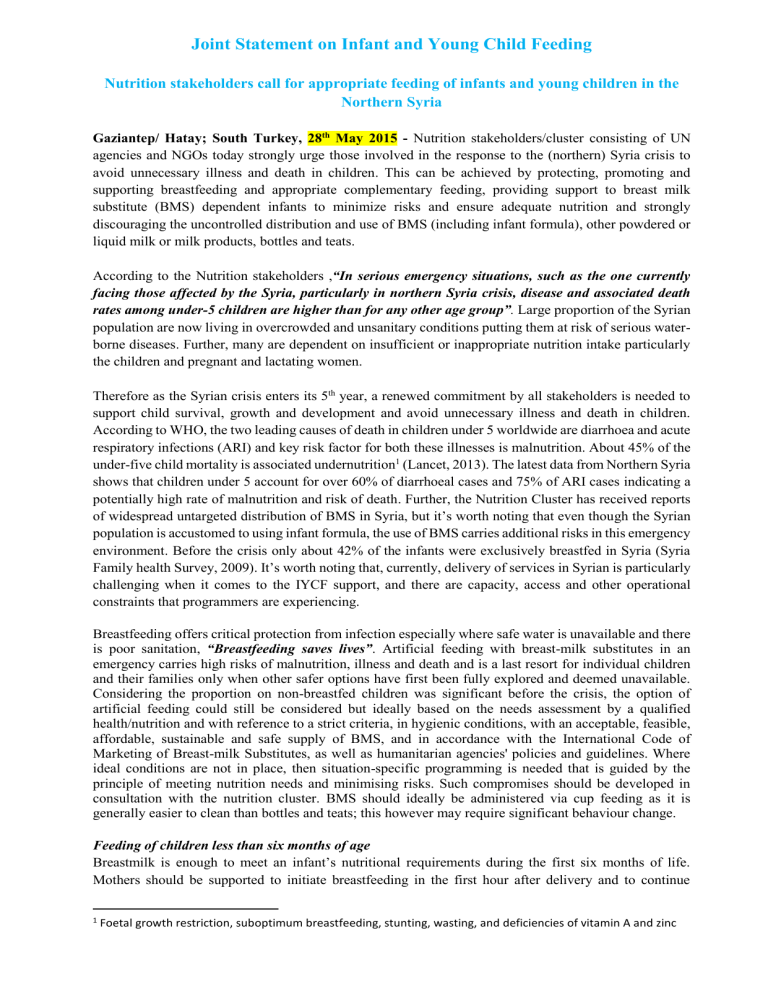
Joint Statement on Infant and Young Child Feeding
Nutrition stakeholders call for appropriate feeding of infants and young children in the
Northern Syria
Gaziantep/ Hatay; South Turkey, 28 th May 2015 Nutrition stakeholders/cluster consisting of UN agencies and NGOs today strongly urge those involved in the response to the (northern) Syria crisis to avoid unnecessary illness and death in children. This can be achieved by protecting, promoting and supporting breastfeeding and appropriate complementary feeding, providing support to breast milk substitute (BMS) dependent infants to minimize risks and ensure adequate nutrition and strongly discouraging the uncontrolled distribution and use of BMS (including infant formula), other powdered or liquid milk or milk products, bottles and teats.
According to the Nutrition stakeholders , “In serious emergency situations, such as the one currently facing those affected by the Syria, particularly in northern Syria crisis, disease and associated death
rates among under-5 children are higher than for any other age group”.
Large proportion of the Syrian population are now living in overcrowded and unsanitary conditions putting them at risk of serious waterborne diseases. Further, many are dependent on insufficient or inappropriate nutrition intake particularly the children and pregnant and lactating women.
Therefore as the Syrian crisis enters its 5 th year, a renewed commitment by all stakeholders is needed to support child survival, growth and development and avoid unnecessary illness and death in children.
According to WHO, the two leading causes of death in children under 5 worldwide are diarrhoea and acute respiratory infections (ARI) and key risk factor for both these illnesses is malnutrition. About 45% of the under-five child mortality is associated undernutrition 1 (Lancet, 2013). The latest data from Northern Syria shows that children under 5 account for over 60% of diarrhoeal cases and 75% of ARI cases indicating a potentially high rate of malnutrition and risk of death. Further, the Nutrition Cluster has received reports of widespread untargeted distribution of BMS in Syria, but it’s worth noting that even though the Syrian population is accustomed to using infant formula, the use of BMS carries additional risks in this emergency environment. Before the crisis only about 42% of the infants were exclusively breastfed in Syria (Syria
Family health Survey, 2009). It’s worth noting that, currently, delivery of services in Syrian is particularly challenging when it comes to the IYCF support, and there are capacity, access and other operational constraints that programmers are experiencing.
Breastfeeding offers critical protection from infection especially where safe water is unavailable and there is poor sanitation,
“Breastfeeding saves lives”
.
Artificial feeding with breast-milk substitutes in an emergency carries high risks of malnutrition, illness and death and is a last resort for individual children and their families only when other safer options have first been fully explored and deemed unavailable.
Considering the proportion on non-breastfed children was significant before the crisis, the option of artificial feeding could still be considered but ideally based on the needs assessment by a qualified health/nutrition and with reference to a strict criteria, in hygienic conditions, with an acceptable, feasible, affordable, sustainable and safe supply of BMS, and in accordance with the International Code of
Marketing of Breast-milk Substitutes, as well as humanitarian agencies' policies and guidelines. Where ideal conditions are not in place, then situation-specific programming is needed that is guided by the principle of meeting nutrition needs and minimising risks. Such compromises should be developed in consultation with the nutrition cluster. BMS should ideally be administered via cup feeding as it is generally easier to clean than bottles and teats; this however may require significant behaviour change.
Feeding of children less than six months of age
Breastmilk is enough to meet an infant’s nutritional requirements during the first six months of life.
Mothers should be supported to initiate breastfeeding in the first hour after delivery and to continue
1 Foetal growth restriction, suboptimum breastfeeding, stunting, wasting, and deficiencies of vitamin A and zinc
exclusive breastfeeding during the first six months of the child’s life, and to continue breastfeeding up to two years or beyond. In the event that breastfeeding has been interrupted in an infant under six months, the priority should be to re-establish breastfeeding and this should ideally be facilitated by a skilled assistant.
Although stress can temporarily interfere with the flow of breast milk in some women, it is not likely to inhibit breast milk production, provided mothers and infants remain together and are supported to initiate and continue breastfeeding. Mothers who lack food or who are malnourished are still able to breastfeed well. Support to mothers (to ensure access to health services including appropriate breastfeeding counselling, food security, nutrition security and privacy) must be a priority in the current crisis in Syria to help protect their health and well-being and that of their infants.
Even though the prevalence of HIV is low in Syria, mothers known to be HIV positive, should be supported with ARVs as per the national protocol, and should be encouraged to exclusively breastfeed up to six months. They should introduce appropriate complementary feeding practices thereafter and continue breastfeeding up to the age of 12 months.
Examples of situations where BMS are unavoidable include orphans, infants who are separated from their mother and infants who were not breastfed at all when the conflict started. If breastfeeding is not possible, wet nursing (breastfeeding of the infant by another mother) should be explored. Artificial feeding can be initiated, ideally based on a needs assessment by a qualified health/nutrition staff trained in breastfeeding and infant feeding issues. Besides, psychosocial and emotional support should be available for traumatized and depressed mothers that experience difficulty on responding to their infants’ nutritional needs.
Any provision and use of BMS should be carefully monitored to ensure that only the targeted infants receive the product. Ready-to-use infant formula (RUIF) consumed with a cup is recommended in this context. If RUIF is not available and powdered infant formula is the only option, it use can be explored.
The use of these BMS should ideally be accompanied by training on hygiene, preparation and use as well as regular visits of beneficiaries, weight monitoring and provision of equipment for safe preparation to minimize their associated risks. The provision of artificial feeding must continue for as long as the infant requires it. Artificial feeding in an emergency carries high risks of malnutrition, illness and death and
is a last resort only when other safer options have first been fully explored.
Complementary feeding of children above six months of age
Children from the age of 6 to 23 months require nutrient-rich, age-appropriate and safe complementary foods in an adequate frequency and responsive feeding, in addition to continued breast milk. Breastmilk continues to significantly contribute to energy and nutrient intake in children to 2 years of age or beyond.
Infants from 6-12 months who cannot be breastfed, can receive whole, heat treated milk or RUIF alongside other age appropriate complementary foods.
Children from 24 to 59 months can eat family foods; sufficient quantity, quality and frequency of foods need to be ensured. This can be complemented with micronutrient powders to increase dietary quality if needed.
If culturally-acceptable, nutritionally adequate and age-appropriate foods which can be used as complementary foods are available and accessible, these should be prioritized for assistance. If such foods are not available, specialized nutritious food should be provided with appropriate training and support for preparation and use. These options represent a much more appropriate form of assistance than sending milk products in rations for general food distribution while pulses, meat, or fish are preferable to powdered milk. Further, the current nutrition programme expansion is providing multiple micronutrient powder, enabling the programme gap filling on micronutrient to the vulnerable families.
Donations and procurement of breast-milk substitutes and other milk products
In accordance with internationally accepted standards and guidelines, donations of infant formula, other powdered or liquid milk and milk products, bottles and teats should not be made . Experience with past emergencies has shown that excessive quantities of poorly targeted donated products endanger infants’ lives. Any procurement and use of breast-milk substitutes (BMS) should be based on a careful needs assessment according to a strict protocol set out in the Operational Guidance on Infant and Young Child
Feeding in Emergencies. BMS should adhere to international standards and the International Code of
Marketing of Breast milk Substitutes as well as Codex Alimentarius to ensure safety and quality. The
Nutrition Cluster will serve as coordination body for any planned BMS distribution and will release additional guidance to partners. Further, effort will be made at cluster level to technically guide organizations implementing untargeted formula distribution to adhere to the operational guidance on infant
/child assessment for targeted support with BMS. Additional effort will go into mapping of BMS currently available in the country, to facilitate assessing its quantity and quality and for comparison with the possible established needs.
Nutrition stakeholders consisting of UN agencies and NGOs operating in Northern Syria strongly urge all who are involved in funding, planning and implementing the emergency response in Syria to avoid unnecessary illness and death of infants and children by promoting, protecting and supporting breastfeeding and appropriate complementary feeding, by addressing the specific needs of the BMS dependent infants and by preventing the uncontrolled distribution and use of breast-milk substitutes and other milks. Age-appropriate nutrient dense complementary foods need to be made available for infants and young children.
All technical queries and any information about donations should be directed to Nutrition Cluster in
Gaziantep/ Hatay or UNICEF Whole of Syria nutrition focal person.
For more information please contact:
Gaziantep Nutrition Cluster Focal Persons
Aileen Wynne: Email: awynne@sy.goal.ie
; Tel:+905331688747
Kamel Ben Abdallah; Email: kbenabdallah@gmail.com; Tel: +905313723874
UNICEF Whole of Syria focal person in Amman:
James King’ori, Regional Nutrition Specialist, Email: jkingori@unicef.org
, Tel: +962799499729
References:
Sphere (2011) Humanitarian Charter and Minimum Standards in Humanitarian Response .
Includes standards on infant and young child feeding in emergencies
Available in English, Arabic, French and other languages at: http://www.sphereproject.org/handbook/languageversions/
The Operational Guidance on Infant and Young Child Feeding in Emergencies – sets out the dos and don’ts during an emergency response. Endorsed by WHA resolution 63.23, 2010 and referred to in Sphere. Available in English,
Arabic, French and other languages at: http://www.ennonline.net/resources/6
Guide for the media on infant and young child feeding in emergencies: The English version of the guidance and addendum is available on: http://files.ennonline.net/attachments/1001/ops-guidance-2-1-english-010307-withaddendum.pdf
. Other language versions are on: http://www.ennonline.net/operationalguidanceiycfv2.1
but might not have the addendum.
International Code of Marketing of Breast-milk Substitutes and subsequent relevant World Health Assembly
Resolutions. WHO (1981): http://www.unicef.org/nutrition/files/nutrition_code_english.pdf
and: http://www.ibfan.org/site2005/Pages/list2.php?iui=1&cat_id=46
Global Nutrition Cluster Toolkit on Nutrition in Emergencies: http://www.unicef.org/nutritioncluster/index_iycf-e.html
Additional orientation, training and other materials on infant and young child feeding in emergencies is available free at: www.ennonline.net/ife
UNICEF, WHO, WFP Joint statement on “Preventing and controlling micronutrient deficiencies in populations affected by an emergency” 2010: www.who.int
